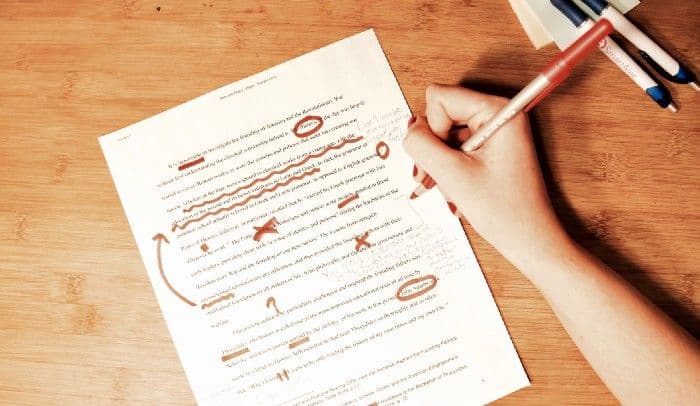
How to (Peacefully) Help Your Child with Essay Writing
Having trouble working with your child on their essay? We understand how you’re feeling.

Essay writing is a skill students are expected to learn in middle school and master in high school, but writing is often challenging. Writing is also a very personal process, so even if your child is working on a dry academic essay, they might feel self-conscious about showing you their work.
Don’t fret, we’re here to help! At Ivy Tutors Network, we pride ourselves in our tutors’ ability to guide a student through the writing process without losing their unique voice. You can do this too. The trick is to put yourself in the role of your child’s editor.
Writers and editors have a symbiotic relationship. They work together to make a piece of writing strong. In this relationship, the editor plays a supportive role—a sort of curator in the gallery where the writer’s work is being displayed. To relieve tension or opposition, we’ve found that it helps for parents and educators to talk through this writer-editor relationship with the student, explaining that this is exactly the way professional authors work. In fact, none of the TV shows, movies, blog posts, magazine articles, or books that we like would exist without editors.
Now, let’s go through a standard essay-writing process and look at exactly how we can help your child’s writing reach its maximum potential.

1. Brainstorming
The first step to writing is brainstorming. Whether it is a creative personal essay or an academic one, students need to start with strong ideas. Let your child start by thinking alone about their essay subject. Note-taking is an essential part of the brainstorming process, so encourage your child to write down any ideas that come into their mind, no matter how outlandish or silly.
Next, sit down together and discuss the notes. If you don’t understand something, ask them to explain it out loud. This exercise often helps students articulate ideas they had trouble expressing in writing. The act of explaining also helps students realize which ideas are strongest. If they have a lot to say about a particular point, chances are they have a lot to write about. Weaker ideas are often ones that can be explained in a sentence or two, but can’t be taken much further than that.
If you think there might be more to an idea than your child realizes, suggest it to them! If they don’t like it, discard it. Your job is to help them flesh out their notes, but they should always have the final say.
2. Outlining
After you and your child have gone through all their notes, it’s time to work on an outline. The standard essay format that most students are asked to write is the five-paragraph essay: an introduction, three body paragraphs, and a conclusion. Even for personal essays, this is a safe format to follow. Some essays might have two body paragraphs, others four—make sure to take a good look at the prompt for specific instructions on structure. For example, some essays need to include quotes from a text, others don’t.
Making an outline with your child can be a great way to work together. It helps them know that they’ve worked out a solid structure for their paper (which instills confidence), while also giving them room to write the essay as they see fit.
3. Writing the First Draft
Now onto the first draft. This is something the student should do completely on their own. Part of writing an essay entails discovering how to proceed. Often the writing isn’t very good at this stage—what matters is getting something down on the page. Encourage your child to struggle through this process! A first draft doesn’t need to be polished—it just needs to be written down.
Some things the student should keep in mind as they write:
- An introduction should succinctly explain how the prompt will be addressed and always needs to give the reader a clear roadmap for how the essay will unfold.
- Each body paragraph needs to directly and clearly address what is being asked in the prompt. If quotes are being used, make sure to focus on textual analysis and explain how the quotes support your ideas.
- A conclusion must restate the essential points outlined in the essay, but never verbatim, and ideally with some final insight. This could come in the form of a personal experience, an anecdote learned from a book, a pertinent quote, etc.
4. Revising
This is where you should jump back in to help your child. Once the first draft is written, have the student reread it to check for spelling or grammar errors. Students often don’t bother to proofread their writing and should get in the habit of doing this early on. Once the essay is proofed, offer suggestions that you think might make it stronger. If you feel, for example, that one idea is not as fully fleshed out as the others, suggest some ways they might be able to amplify it. If the student has made a grammatical error, don’t just fix it for them—explain why it is a mistake and how it can be avoided in the future.
If your child has some significant changes to make, encourage them to sit back down and do some rewrites. Then come back to the essay together and repeat these steps until you both feel the essay is as strong as it can be.

5. Writing the Final Draft
Last but certainly not least, it’s really important to have your child read over the essay one final time to take full ownership of the final product. Have them check for typos, word repetition, unnecessary wordiness, awkward syntax, incorrect punctuation and any other small details they might’ve missed.
There you have it: how to support your child’s essay-writing, while avoiding the tension in helping when it’s not wanted or they're not ready. When you step back into an editor role, you’ll help your child learn to express their ideas, gain confidence, and practice good habits such as outlining and proofreading. With good experiences early on, your child could go on to fall in love with writing, setting themselves up for success in school and life.

